The Black-necked Stork, also known as the Jabiru, is a majestic wading bird characterized by its striking black neck and head, contrasting with a predominantly white body.
Found in wetlands and water bodies across Asia and Australia, this species is captivating with its tall stature and graceful presence.
Renowned for its elaborate courtship displays and specialized feeding habits, the Black-necked Stork holds cultural significance in indigenous folklore and plays a vital ecological role as a top predator in its habitat.
As we go through the biography of this remarkable bird, we uncover its fascinating life history, behaviors, conservation challenges, and the efforts undertaken to ensure its survival. So, stay sharp.
Individualizing Criteria of Black-necked Stork
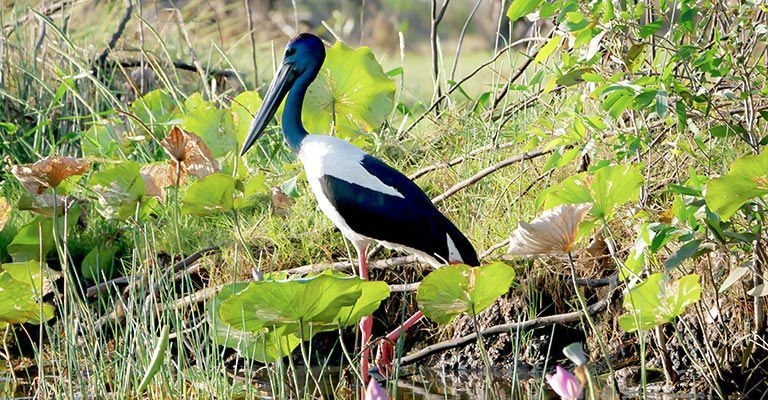
The Black-necked Stork (Ephippiorhynchus asiaticus), also known as the Jabiru, is a large wading bird native to parts of Asia and Australia.
Identifying this majestic bird requires attention to detail and knowledge of its distinctive features. Here are some key points to help you determine the Black-necked Stork:
Size and Shape
The Black-necked Stork is a large bird, standing between 3.5 to 4.5 feet tall, with a wingspan of up to 7.5 feet.
Its body is robust, with long legs adapted for wading through shallow water. The neck is long and slender, leading to a large, thick bill.
Coloration
As the name suggests, the distinguishing feature of the Black-necked Stork is its black neck and head.
The rest of the body is predominantly white, with contrasting black flight feathers and tail. During the breeding season, adults develop a pinkish tinge on the lower neck and chest.
Bill
The bill of the Black-necked Stork is long, straight, and dagger-shaped. It is yellowish-orange, with a slight downward curve at the tip.
The bill is used for catching prey, primarily fish, frogs, insects, and small reptiles.
Head and Neck
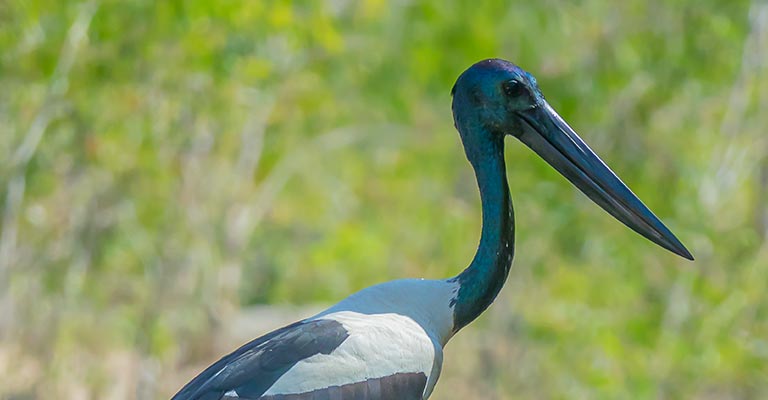
The head of the Black-necked Stork is large and angular, with a distinctive black cap extending down the back of the neck.
The eyes are small in proportion to the head and are positioned towards the front, giving the bird excellent binocular vision for hunting.
Legs and Feet
The legs of the Black-necked Stork are long and slender, adapted for wading in shallow water.
The feet are large and partially webbed, aiding stability while walking on mud or soft substrates. The color of the legs varies from dull pink to reddish-orange.
Flight
In flight, the Black-necked Stork displays striking black and white coloration, contrasting wingtips and tail.
Its flight is slow and steady, with deep wingbeats. When flying, the neck is stretched straight, and the legs extend beyond the tail.
Habitat
Black-necked Storks inhabit wetland habitats such as freshwater marshes, swamps, and billabongs.
They can also be found in rivers, floodplains, and rice fields. These birds prefer areas with shallow water where they can wade and forage for food.
Behavior
When foraging, Black-necked Storks are often seen standing motionless in the water, patiently waiting for prey to come within striking distance.
They use their sharp bill to spear or grasp food items, swallowing them whole or tearing them into smaller pieces.
Identifying the Black-necked Stork requires careful observation of its size, coloration, bill shape, and habitat preferences.
By paying attention to these critical characteristics, birdwatchers and enthusiasts can easily distinguish this magnificent species in the wild.
Taxonomy of Black-necked Stork
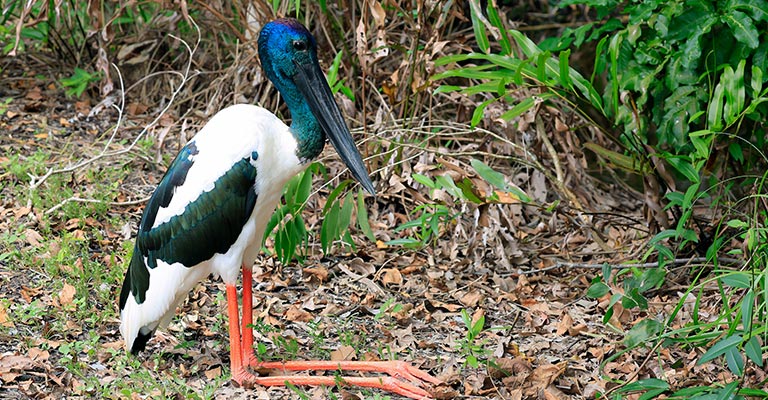
Here’s an excellent table detailing the taxonomy of the Black-necked Stork:
| Domain | Eukaryota |
| Kingdom | Animalia |
| Phylum | Chordata |
| Class | Aves |
| Clade | Aequornithes |
| Order | Ciconiiformes (Bonaparte, 1854) |
| Family | Ciconiidae |
| Genus | Ephippiorhynchus |
| Species | E. asiaticus |
The Black-necked Stork, scientifically known as Ephippiorhynchus asiaticus, comprises two recognized subspecies: E. a. asiaticus, found in the Oriental region, and E. a. australis, inhabiting South New Guinea and Australia.
Despite being subspecies of the same species, they exhibit some differences in distribution, habitat preferences, and possibly minor morphological variations.
Ephippiorhynchus asiaticus asiaticus (Oriental Region)
- It is found in the Oriental region, including India, Bangladesh, Myanmar, Thailand, Cambodia, and Vietnam.
- Inhabits various wetland habitats such as freshwater marshes, swamps, rivers, and rice fields.
- This subspecies may exhibit adaptations specific to the conditions of the Oriental region, such as different prey preferences or nesting behaviors.
Ephippiorhynchus asiaticus australis (South New Guinea and Australia)
- Indigenous to South New Guinea and Australia, including regions like Queensland, the Northern Territory, and northern Western Australia.
- It prefers similar wetland habitats as its Oriental counterpart but may show preferences for specific types of water bodies or vegetation.
- It might display subtle morphological differences or behavioral adaptations suited to the environmental conditions of its range.
Despite these differences, both subspecies of the Black-necked Stork share common characteristics, such as their distinctive black and white plumage, tall stature, specialized feeding habits, and significant ecological roles in their respective habitats.
Reproduction of Black-necked Stork
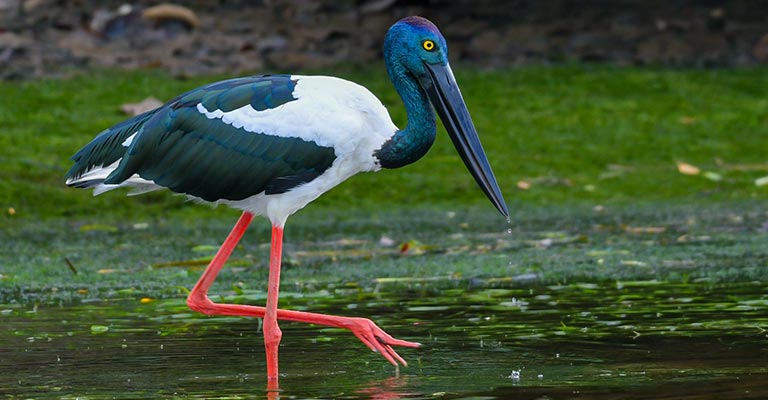
The reproduction process of the Black-necked Stork typically begins with courtship displays, which involve elaborate rituals such as bill-clapping, posturing, and vocalizations.
Once a pair forms a bond, they construct a large nest of sticks, reeds, and other vegetation, often situated in tall trees or on elevated platforms near water bodies.
The female usually lays a clutch of 2-5 eggs, which both parents take turns incubating for about 30-40 days.
After hatching, the chicks are precocial and are cared for by both parents, who feed them regurgitated food. The chicks fledge after around 70-90 days but may remain dependent on their parents for several more weeks.
Black-necked Storks typically breed once a year, with breeding seasons varying depending on the geographical location.
Black-necked Stork Life History
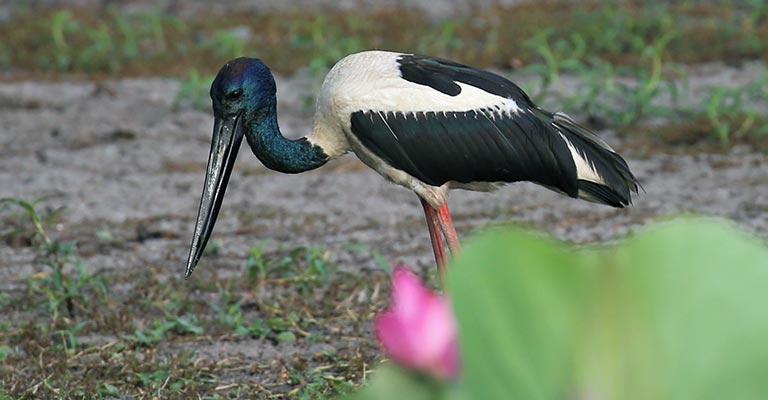
The Black-necked Stork (Ephippiorhynchus asiaticus), also known as the Jabiru, is a striking wading bird renowned for its distinctive appearance and graceful presence.
This species plays a vital role in the ecosystems it inhabits, particularly wetlands and water bodies across Asia and Australia.
Understanding its history provides insight into its behavior, ecology, and conservation needs.
Food
Black-necked Storks are opportunistic feeders, primarily consuming fish, frogs, insects, crustaceans, and occasionally small mammals or reptiles.
Their long, sharp bill allows them to capture prey in shallow water habitats efficiently. They employ a patient stalking technique, often standing motionless or moving slowly while foraging.
Habitat
These storks inhabit various wetland habitats, including freshwater marshes, swamps, billabongs, rivers, and rice fields.
They prefer shallow water, abundant vegetation, and ample prey availability. Human disturbances, habitat loss, and pollution threaten their preferred habitats.
Range Map
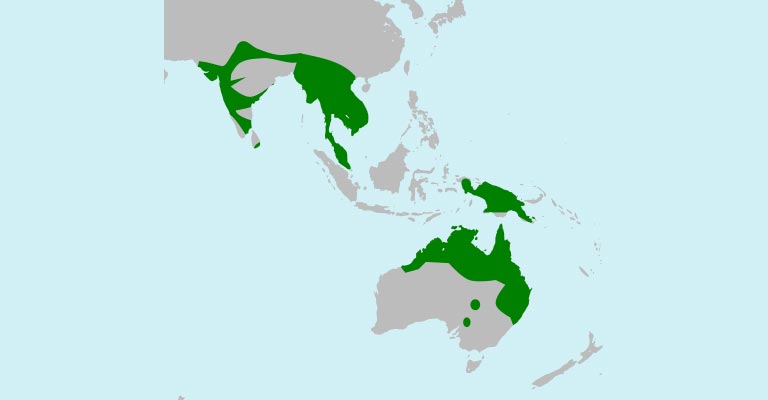
The range of the Black-necked Stork extends across parts of South and Southeast Asia, including India, Bangladesh, Myanmar, Thailand, Cambodia, Vietnam, and Indonesia.
In Australia, they are found primarily in the northern and eastern regions, including Queensland, the Northern Territory, and northern Western Australia.
Nesting
During the breeding season, Black-necked Storks construct large nests made of sticks, reeds, and vegetation in tall trees or on elevated platforms near water.
The female typically lays a clutch of 2-5 eggs, which both parents incubate for 30-40 days. After hatching, the chicks are cared for by both parents and fledge after 70-90 days.
Here’s a table for you detailing the nesting details of the Black-necked Stork:
| Nesting Details | Facts |
| Clutch Size | 2-5 eggs |
| Number of Broods | Typically 1 per breeding season |
| Egg Length | Approximately 8-10 cm |
| Egg Width | Approximately 5-6 cm |
| Incubation Period | 30-40 days |
| Nestling Period | 70-90 days |
| Egg Description | Off-white to pale green with a smooth surface |
| Nest Type | Large nest made of sticks, reeds, and vegetation |
| Nest Location | Tall trees or elevated platforms near water bodies |
| Parental Care | Both parents share incubation and feeding duties |
| Nesting Success Rate | Varies depending on environmental factors and predation risk |
This table provides a concise overview of the nesting characteristics of the Black-necked Stork, including clutch size, incubation period, nest type, and parental care.
Diseases and Treatment
Like many bird species, Black-necked Storks are susceptible to various diseases, including avian botulism, avian influenza, and avian tuberculosis.
Treatment typically involves veterinary care, including medication, supportive therapy, and quarantine measures to prevent the spread of contagious diseases.
Conservation
The conservation of Black-necked Storks is crucial to maintaining the health and biodiversity of wetland ecosystems. Threats such as habitat loss, pollution, human disturbance, and hunting pose significant challenges to their survival.
Conservation efforts focus on habitat restoration, protected area management, research, education, and community engagement to mitigate these threats and ensure the long-term viability of Black-necked Stork populations.
The life history of the Black-necked Stork is intricately linked to its food habits, habitat preferences, nesting behavior, health concerns, and conservation needs.
By understanding and addressing these factors, we can work towards safeguarding this magnificent species for future generations.
10 Fun Facts About Black-necked Stork
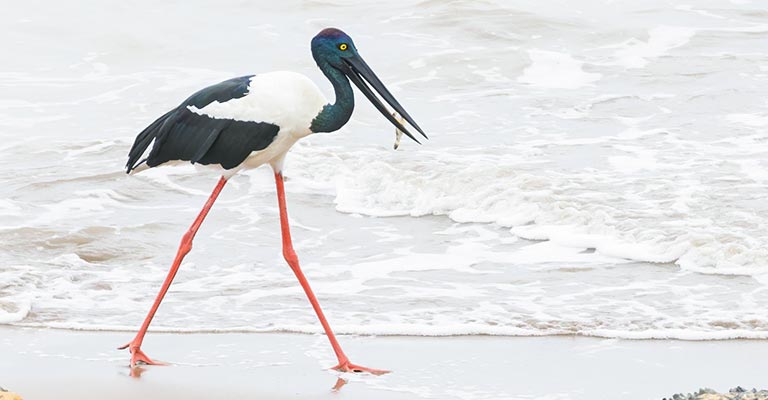
The Black-necked Stork, also known as the Jabiru, is a fascinating bird species with various unique characteristics and behaviors. Here are 10 fun facts about these majestic birds:
- Tallest Wading Bird: The Black-necked Stork is one of the tallest wading birds in the world, standing between 3.5 to 4.5 feet tall, with some individuals reaching even greater heights.
- Distinctive Coloration: As their name suggests, Black-necked Storks have a striking black neck and head, contrasting with their predominantly white body feathers.
- Elaborate Courtship Rituals: During the breeding season, Black-necked Storks engage in elaborate courtship displays, including bill-clapping, posturing, and vocalizations, to attract mates.
- Long Lifespan: These storks can live for up to 20 years or more in the wild, displaying remarkable longevity for a bird species.
- Precocial Chicks: Black-necked Stork chicks are precocial, meaning they are relatively well-developed at birth and capable of moving around shortly after hatching.
- Global Distribution: While primarily found in parts of Asia and Australia, Black-necked Storks have a wide distribution range, including countries such as India, Australia, Myanmar, and Indonesia.
- Specialized Feeding Behavior: They are skilled hunters, using their long, sharp bills to spear fish, frogs, insects, and other small prey in shallow water habitats.
- Vocal Communication: Black-necked Storks communicate through various vocalizations, including loud honking calls during flight and softer grunts during courtship and nesting activities.
- Conservation Concerns: Despite their adaptability, Black-necked Storks face threats from habitat loss, pollution, and human disturbance, highlighting the importance of conservation efforts to protect their populations.
- Cultural Significance: In some indigenous cultures, Black-necked Storks are revered as symbols of power, grace, and wisdom, featuring prominently in folklore and traditional ceremonies.
These fun facts offer a glimpse into the fascinating world of the Black-necked Stork, showcasing their unique adaptations, behaviors, and ecological significance.
Wrapping Up
The Black-necked Stork is a captivating bird species that embodies grace, resilience, and natural beauty.
From its distinctive appearance and elaborate courtship rituals to its specialized feeding behaviors and global distribution, the Black-necked Stork fascinates and inspires bird enthusiasts and conservationists alike.
By raising awareness about the importance of protecting their habitats and addressing conservation challenges, we can ensure the continued survival of this magnificent species for future generations to admire and appreciate. Thank you very much.